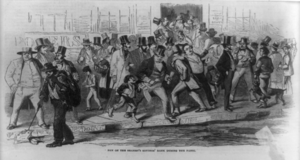List of recessions in the United States
There have been as many as 48 recessions in the United States dating back to the Articles of Confederation, and although economists and historians dispute certain 19th-century recessions,[1] the consensus view among economists and historians is that "the [cyclical] volatility of GNP and unemployment was greater before the Great Depression than it has been since the end of World War II.
The NBER defines a recession as "a significant decline in economic activity spread across the economy, lasting more than two quarters which is 6 months, normally visible in real gross domestic product (GDP), real income, employment, industrial production, and wholesale-retail sales".
Their work is aided by historical patterns, in that recessions often follow external shocks to the economic system such as wars and variations in the weather affecting agriculture, as well as banking crises.
[5] Major modern economic statistics, such as unemployment and GDP, were not compiled on a regular and standardized basis until after World War II.
[8][9] Beginning in 1835, an index of business activity by the Cleveland Trust Company provides data for comparison between recessions.
Modern economic statistics, such as gross domestic product and unemployment, were not gathered during this period: Victor Zarnowitz evaluated a variety of indices to measure the severity of these recessions.
[40] The National Bureau of Economic Research dates recessions on a monthly basis back to 1854; according to their chronology, from 1854 to 1919, there were 16 cycles.
[45][46] The creation of the Federal Reserve System in 1913 has been disputed as a source of stability with it and its policies having mixed successes.
[47][48] Since the early 1980s the sources of the Great Moderation has been attributed to numerous causes including public policy, industry practices, technology, and even good luck.



